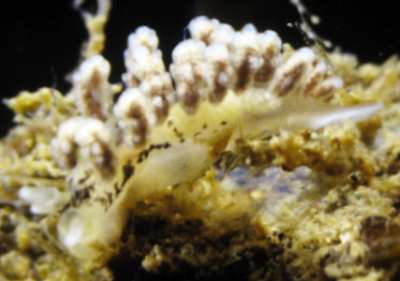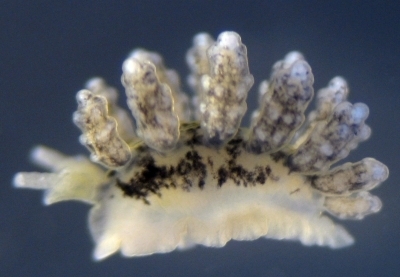

Doto kya
Marcus, 1961
Order: NUDIBRANCHIA
Suborder: DENDRONOTINA
Family: Dotidae
DISTRIBUTION
Distribution: Bamfield, Vancouver Island, British Columbia (Millen 1983) to Punta Cabras, Baja California, Mexico (Hamann 1981)
PHOTO
Upper: North Cove, Cape Arago, Oregon, USA. Pacific coast. Intertidal. Length: 10 mm. May 1980. Rocky shore. Photographer: Jeff Goddard. Lower: Scott Creek, Santa Cruz County, Intertidal, California, USA, Pacific, 12 June 2006, Rocky shore. Length: 4 mm. Photographer: Jeff Goddard.
Along with Doto columbiana, Doto kya is one of two species of Doto known from the cold temperate waters of the northeastern Pacific Ocean with dark pigmentation on the body, head, rhinophore sheaths and cerata. The brown to black pigmentation is darker and more concentrated than in Doto columbiana and occurs on the sides of the body, especially anteriorly [Upper photo], but not on the sides of the foot as in Doto columbiana. This difference in pigmentation persists in specimens preserved in ethanol [Lower photo] and can be used to distinguish preserved Doto kya from Doto columbiana. There are 6 to 9 (usually 7 to 8) pairs of cerata with ovoid, upward-pointing tubercles. Varying amounts of dark, subcutaneous pigmentation occur between the tubercles, and when dense, may form rough rings around the tubercles. The ground color of the body is translucent white, and the rhinophores and their sheaths contain opaque white, spherical bodies.
Adults measure up to about 10 mm long and are usually found with their egg masses associated with the basal stolons of Plumularia spp., often growing on perennial brown algae, such as Cystoseira osmundacea. Like Doto columbiana, the larvae of Doto kya are planktotrophic (Goddard 1996, 2005), and the adults can be locally abundant.
Although Doto kya was described from a single preserved specimen (supplemented with the collector's notes on the living specimen), Marcus' description and illustrations of the specimen, especially the pigmentation on the body, are unequivocal. Doto kya is depicted in Behrens (1991) and Behrens and Hermosillo (2005) under both Doto kya and Doto columbiana.
-
Behrens, D.W. 1991. Pacific Coast Nudibranchs. Sea Challengers, Monterey, California. 107 pp.
-
Behrens, D.W. and Hermosillo, A. 2005. Eastern Pacific Nudibranchs. Sea Challengers, Monterey, California. 137 pp.
-
Hamann, J. 1981. Range extensions of northeast Pacific opisthobranchs. Opisthobranch Newsletter, 13: 21.
-
Marcus, E. 1961. Opisthobranch mollusks from California. The Veliger, 3(Supplement 1): 1-85.
-
Goddard, J.H.R. 1996. Lecithotrophic development in Doto amyra (Nudibranchia: Dendronotacea), with a review of developmental mode in the genus. The Veliger, 39: 43-54.
-
Goddard J.H.R. 2005 (for 2004). Developmental mode in opisthobranchs molluscs from the northeast Pacific Ocean: feeding in a sea of plenty. Canadian Journal of Zoology, 82: 1954-1968.
-
Millen, S.V. 1983. Range extensions of opisthobranchs in the northeastern Pacific. The Veliger, 25: 383-386.
Goddard, J.H.R., 2006 (February 9) Doto kya Marcus, 1961. [In] Sea Slug Forum. Australian Museum, Sydney. Available from http://www.seaslugforum.net/factsheet/dotokya
Related messages
-
Doto kya from central California
From: Jeff Goddard, August 31, 2006 -
Doto kya from Northern California
From: John Albers-Mead, August 19, 2006 -
Fact sheet for Doto kya
From: Jeff Goddard, February 9, 2006 -
Doto kya from Oregon
From: Jeff Goddard, January 31, 2006 -
Doto kya from British Columbia
From: Marli Wakeling, April 19, 2002
